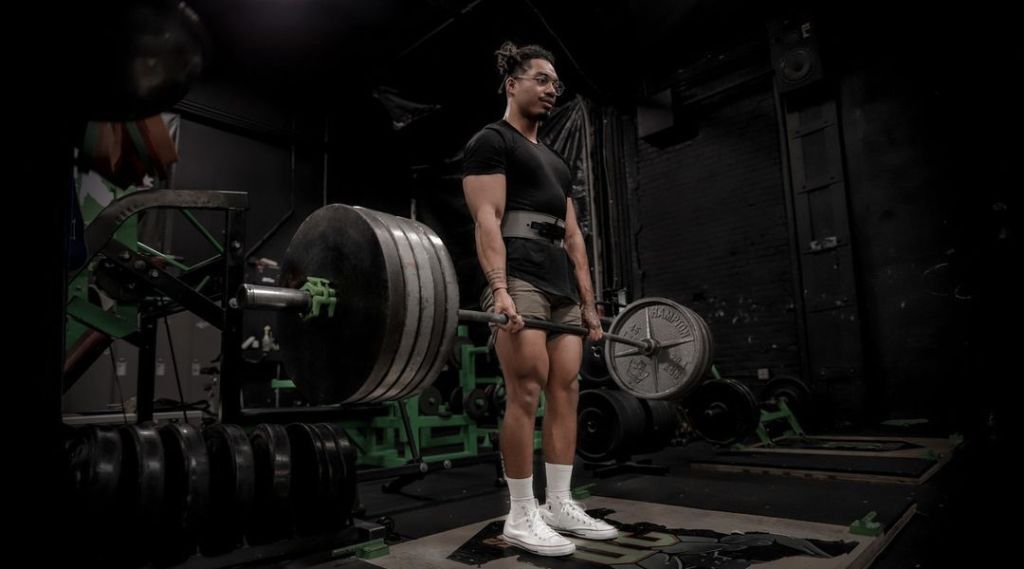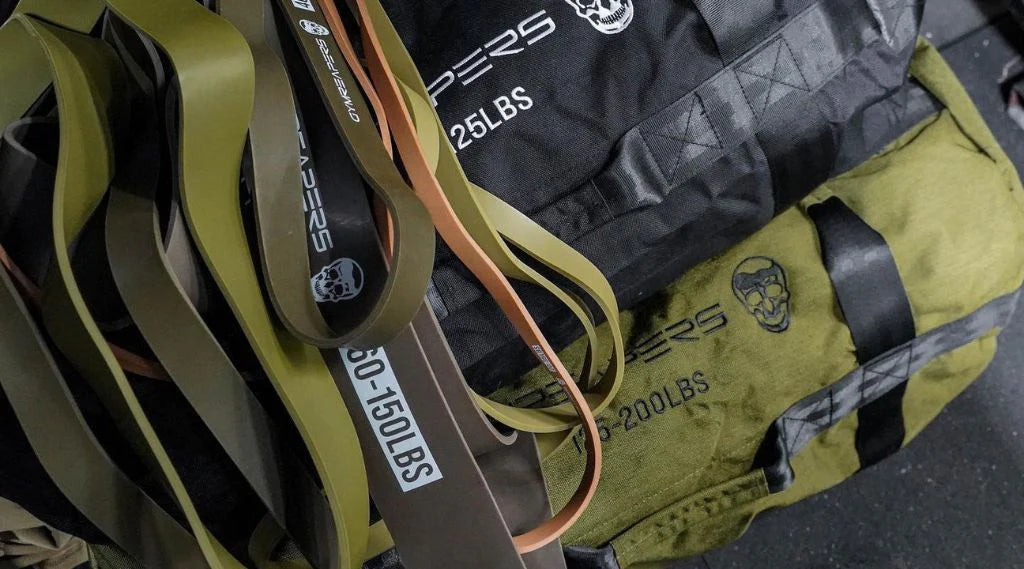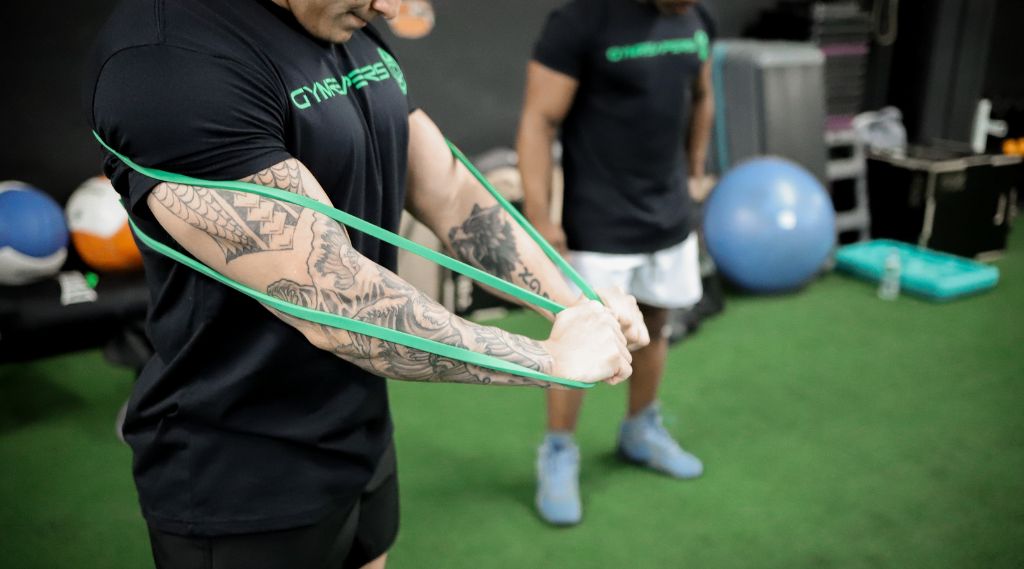If you want to improve your deadlift strength, especially in the lock-out, then you should start incorporating banded deadlifts.
A banded deadlift is a deadlift variation that adds the resistance of an elastic band. This movement requires you to pull the load from the floor to mid-thigh against increasing resistance from the band, making the top portion of the movement (the lockout) more difficult.
I’ll dive into the details of how to perform the banded deadlift properly, what common mistakes to watch out for, and how to start incorporating them into your training plan.
What Is A Banded Deadlift?
There are two different versions of the banded deadlift, one involves using bands to make a barbell deadlift more challenging; the other involves performing a deadlift movement pattern (hip hinge) using only a band for resistance.
I’ll touch on both variations of the banded deadlift in this article, but the main focus will be on the barbell variation as it is more complex to perform and set up.
Related Article: 12 Best Back Exercises With Resistance Bands (+ Sample Workout)
Muscles Used For Banded Deadlifts
The banded deadlift, like the regular deadlift, works your entire posterior chain (backside of your body), your legs, and your core but the increasing resistance of the band places more emphasis on the muscles used in the lockout.
These muscles include:
Gluteus Maximus (Glutes)
The glutes are responsible for extending your hips, so they are targeted in the lockout portion of the deadlift to bring your hips underneath you.
The banded deadlift requires even more glute activation than a standard deadlift because the tension the band provides will be at its peak when your glutes are working to extend the hips at the top of the movement.
Hamstrings
Your hamstrings are the muscles running down the back of your thighs. They work with your glutes to extend your hips and help you stand up straight in the lockout, and they help to stabilize the knee in the start position.
Quadriceps (Quads)
Your quads, located at the front of your thighs, are responsible for extending your knees as you lift. The quads work in tandem with your glutes and hamstrings to stand up against the increasing resistance of the bands; however, the quads are most active at the bottom portion of the deadlift to initiate the movement, whereas the glutes are most active at the lockout.
Erector Spinae (Lower Back)
These muscles run along your spine and are essential for maintaining a neutral spine (straight back) as you lift. The banded deadlift really challenges these muscles to keep your spine from rounding as the tension in the band increases at the top of the lift.
Latissimus Dorsi (Lats)
Your lats, the broad muscles on each side of your back, help keep the band (or bar) close to your body during the lift, stabilizing your torso against the resistance.
Trapezius and Rhomboids (Upper Back)
Located in your upper back, these muscles work to keep your shoulder blades retracted (squeezed back) and your back straight during the lift, helping you maintain proper posture and alignment.
Core Muscles (Abs and Obliques)
Last but not least, is your core. During a banded deadlift, your abs and obliques work overtime to stabilize your body, keeping you balanced as you battle against the band's resistance and the weight on the barbell.
Related Article: How to Do Bent Over Rows With Bands (The Proper Way)
Benefits Of Banded Deadlifts

There are several reasons to incorporate banded deadlifts into your programming:
Increased Resistance at the Top
Banded deadlifts provide a unique challenge as the resistance increases at the top of the lift. This forces your muscles to work harder at the point where they would usually get a break, enhancing strength development and power output.
Improved Speed and Explosiveness
The extra resistance at the top of the movement encourages you to lift more explosively from the floor, so you can use that momentum and speed as the resistance increases. This improvement in power and speed can transfer well to your total force output in a max-effort barbell deadlift.
Better Technique
The bands help reinforce good deadlift technique because they encourage you to keep the bar close to your body and to fully extend your hips at the top of the lift, which can help improve your overall strength and reduce your risk of injury.
Strengthening Weak Points
If you struggle to lock out your deadlifts at the top, banded deadlifts can be a game-changer. The added resistance at the top of the lift specifically targets this common weak point, without requiring you to add more weight and make the bottom portion of the lifter harder as well.
Versatility and Progression
Resistance bands come in a variety of tensions, making it easy to adjust the difficulty of the lift as you progress. This flexibility makes banded deadlifts a versatile tool for lifters of all levels.
For example, it can be performed with just a band for those who are new to the movement, or it can be adapted for more advanced lifters by wrapping bands around a barbell to increase the difficulty of a barbell deadlift.
Related Article: Banded Squats: Benefits, How-to, Common Mistakes
How To Perform Banded Deadlifts Correctly
To reap the benefits of the banded deadlift, you’ll need the right equipment and the proper technique.
Note: The following instructions are for the more advanced version of the banded deadlift that involves adding resistance bands to a barbell deadlift. However, you can reference these instructions for a band-only deadlift for tips on proper positioning.
Equipment Needed
- A barbell with weight plates
- Resistance bands (We highly recommend GymReaper's bands due to their superior durability and varying tension levels)
- Optional: heavy dumbbells or a rack to attach the bands to (if you’re using 2 bands instead of 1).
Step 1: Set Up Your Band
Attach your resistance band(s) to the barbell and secure it to the platform, under your feet, or with a set of heavy dumbbells.
If you’re securing the bands to the platform or with a set of heavy dumbbells, then you’ll need two bands (one band anchoring each side of the bar).
If you’re securing the bands under your feet, then you likely only need one band looped over the barbell (as shown in the video).
Step 2: Position Your Feet
Stand with your feet shoulder-width apart, with your toes under the barbell. Secure the band beneath your feet if using a single band. If using the double band setup, then ensure the bands are equally spaced and position yourself in the middle.
Step 3: Grip The Bar
Bend at your hips and knees, keeping your back straight, and grab the bar. You can use a double overhand grip or a mixed grip (one hand over, one hand under), whichever you prefer.
Step 4: Engage Your Core
Before you start the lift, tighten your core. Imagine you're about to be punched in the stomach and bracing for it - that's the kind of tension you want. This bracing will help you engage your core and erectors and protect your spine during the lift.
Step 5: Lift The Bar
Stand up by pushing the ground away with your legs to extend your knees and hips. As you lift the bar, drive your hips forward and pull your shoulders back to stand tall. You should feel the increased tension from the band as you near the top of the lift.
Step 6: Lower The Bar
Once you've fully extended, begin to lower the bar by pushing your hips back and bending your knees. Keep the bar close to your body as you return it to the ground.
4 Banded Deadlift Mistakes (And How To Fix Them)
Now that you know how to perform the movement, you should also be aware of the common mistakes that people make with this exercise and how to fix them.
Using Too Much Band Resistance
While it's tempting to jump right in with a heavy-duty band, too much resistance can throw off your technique and increase your risk for injury.
You’ll be able to tell if you’re using too much resistance if you’re struggling to lock out at the top of the movement. If the bar isn’t moving smoothly to the lockout, then take it back a notch.
How To Fix It
Start with a lighter band and work your way up. Remember that the goal is to increase the difficulty of the movement at the top of the lift, so you should choose a band that provides the appropriate amount of tension for that portion of the lift (not one that feels challenging right off the floor).
Not Getting Enough Band Tension
While less common than the first mistake, you could also be failing to use enough resistance. If you’re starting out with a lighter band and don’t progress to a heavier one over time, then you won’t get stronger or more proficient.
How To Fix It
Ensure you're using an appropriate band for your strength level. If you're breezing through your reps without feeling the extra challenge at the top of the lift, it might be time to upgrade to a higher resistance band.
You can also judge by how many reps you feel you have “left in the tank”. If you’ve programmed 3 sets of 6 reps of banded deadlifts, and by the final set you feel like you could still do 3 or more reps, then use a heavier band next time.
Setting Up The Bands Unevenly
Another common pitfall is setting up the bands unevenly, causing the bar to be off-balance. Typically this happens if you’re using a double band set-up and one band is pulling tighter than the other, or if you’re using a single band set-up and you’re not standing directly in the middle of the band.
How To Fix It
When setting up your band(s), take the time to ensure they are centered and evenly distributed on both sides of the bar. This might require a bit of adjustment and fine-tuning, but it's well worth the effort. An even setup will not only help you maintain balance during the lift but also ensure that you're working both sides of your body equally.
How To Incorporate Banded Deadlifts Into Your Workout Plan

Here are some programming considerations for integrating banded deadlift into your training plan:
Exercise Order
If you’re performing banded deadlifts with a barbell, then you’ll want to complete this movement earlier in your workout when your energy levels are highest, especially if you're lifting heavy. This is a challenging exercise that requires a lot of effort and good form, so you want to be fresh when you tackle it.
If you’re performing band-only deadlifts, then you can save this exercise for later on in your workout to get in some extra volume after you’ve already performed your main movements (barbell deadlift, squat, etc.)
Frequency
As a rule of thumb, incorporating banded deadlifts (with a barbell) once a week into your routine can be a good starting point. This allows you to get the benefits of the exercise without overdoing it.
If you deadlift more than once a week, then you should include another deadlift variation on the other day because other variations can target different muscles and aspects of the lift, providing a more balanced approach to your training.
If you’re performing band-only deadlifts then you can include them more often (2-3x/week) as they are easier to recover from than banded deadlifts with a barbell.
Sets & Reps
For barbell banded deadlifts, aim for 3-5 sets of 5-8 reps because this rep range allows for a good balance of strength and hypertrophy (muscle building) benefits.
For band-only deadlifts, aim for 3-5 sets of 8-12 reps because the level of resistance will be lower and you’ll have to challenge your muscles by increasing the amount of time your muscles are under tension.
Load
Start with a lighter weight than you would typically use for traditional deadlifts, as the band will add extra resistance. As you get comfortable with the movement, you can gradually increase the weight while ensuring you maintain proper form.
When in doubt, adjust the load based on the number of reps you plan to perform. If you can easily do more reps than prescribed, then increase the load or band resistance. If you’re struggling to perform the number of reps prescribed with good technique, then lower the weight or band resistance.













Leave a comment
All comments are moderated before being published.
This site is protected by hCaptcha and the hCaptcha Privacy Policy and Terms of Service apply.